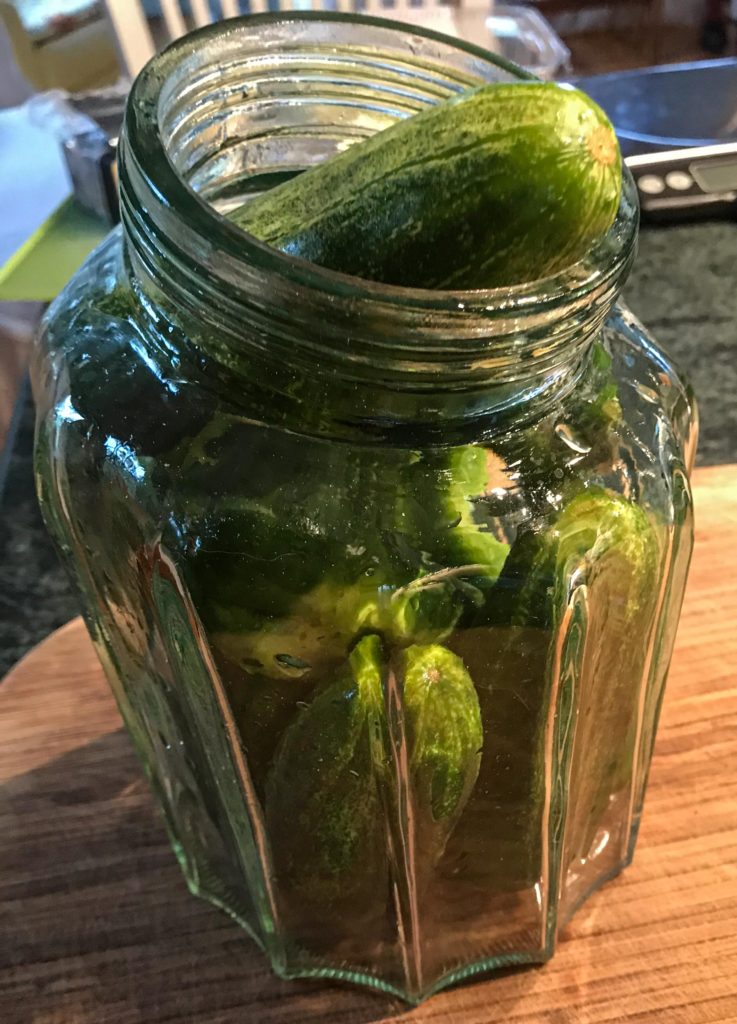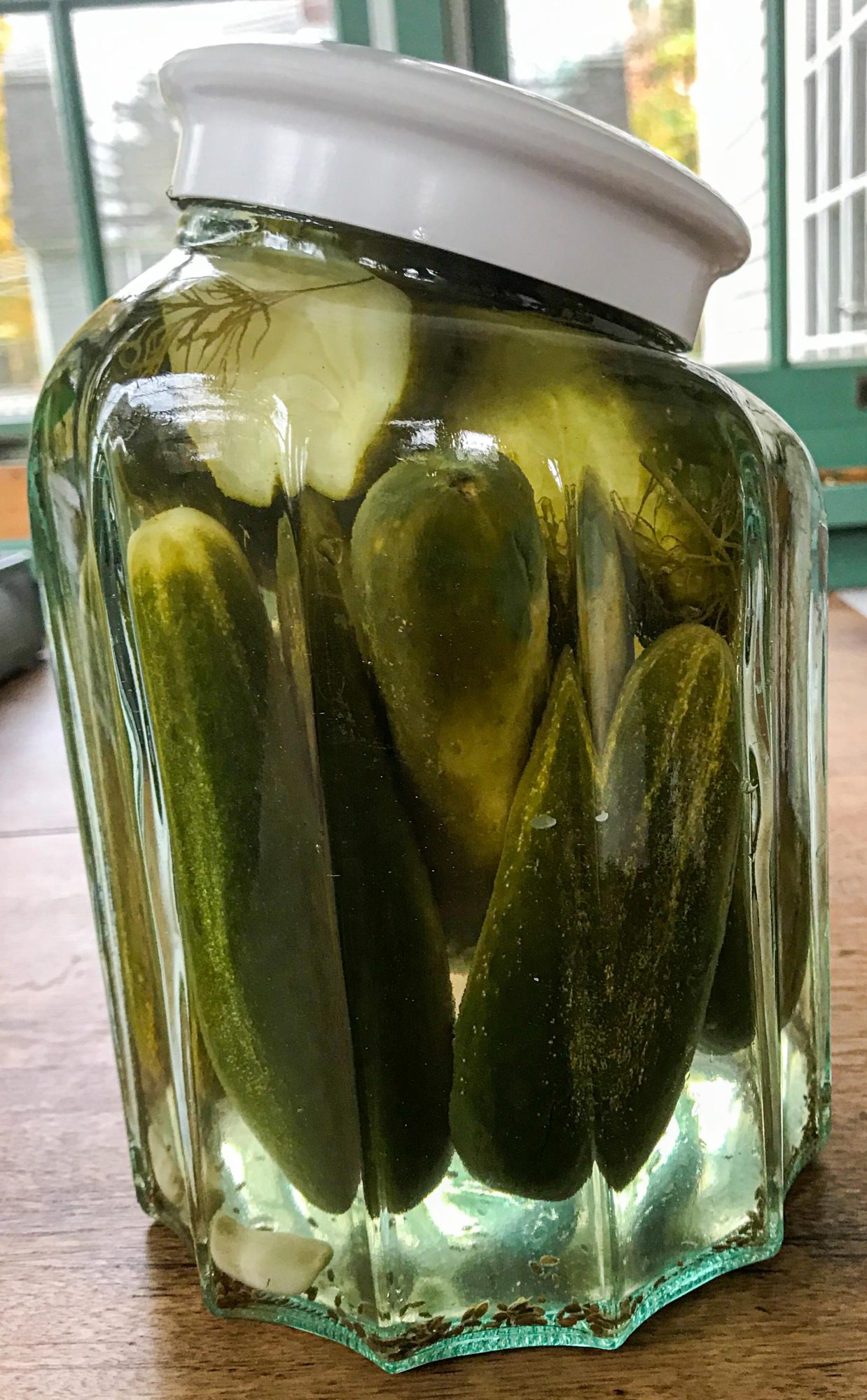
I wouldn’t have thought very young children would like dill pickles until I gave one to my daughter. She was around one at the time, and liked to careen around the kitchen in her walker, hunting for bananas. I didn’t have any fruit handy so I gave her a nice pickle, probably a kosher half-sour. She instantly put it in her mouth and kept it there as if it were a big green binky.
Several minutes later, I was getting a little concerned. The child was just sitting there with the pickle in her mouth and a look of glazed wonder on her chubby little face. I thought perhaps it wasn’t really good for her, especially as she barely had any teeth, so I removed the pickle with some difficulty. I saw she had pierced its green skin with her two sharp little incisors and had been busily sucking out all the juice, like a little blonde pickle vampire.
To a child used to strained peas, that briny juice must have been the taste equivalent of Disney World. I wish I could still experience food that way myself, but it’s probably too late. Or at least it takes more, these days, than a fermented cucumber, though pickles are still a wonderful thing to have around the house, easy to make, and take almost no time at all.
To be sure, Eaters, I generally make plain pickled pickles, as opposed to fermented pickles. The difference is that true fermentation means some sort of bacteria have been whaling away at your vegetation, producing acid and gasses as a by-product. This invariably takes at least a few days if not weeks, and results in a sourness that is, ideally, both pleasant and complex. But you can pickle things just using vinegar as your acid, and stick them right in the fridge.
I freely admit that refrigerator pickles don’t have the echt gestalt of the basement crock variety, but they’re not only good because they’re easy to make. Unfermented pickles are crisp and refreshing, and taste more like the original vegetable. They go well with salads and other cold foods. You can flavor them endlessly, and you can’t really buy them. They have to be yours.
Luckily, you can have your very own pickles in less than an hour from now, shopping time included. And you don’t even really need a recipe. You just need a measuring cup, a scale, and a tiny bit of math.
Fridge Pickles
A quick method for making any non-fermented pickle.

Take a clean jar and pack them with your pickles. I like to try and keep pickles whole , but chunk or slice them if you prefer, or to make them fit better. Add cold water almost to the very top. Drain the water out into a large measuring cup or pitcher. Pour off half the water and replace it with vinegar. Note how much liquid you now have, in milliliters, and put in a saucepan.
OK, math lovers - we're going to make a 5% brine, and a milliliter weighs one gram. So I just divide the amount of milliliters of liquid by 10, cut the result in half, and add that many grams of salt. Or if that doesn't make sense and you have, say, 500 ml of combined water and vinegar (which is roughly two cups), divide 500 by 20 and you find you need 25 grams of salt. Add the salt to the liquid in the pan.
Next up, add three times as much sugar to the saucepan, by weight, as you did salt - 75 grams, in our example.
Finally, add some spices. A few sprigs of dill and/or a bay leaf, some whole peeled cloves of garlic and a generous sprinkle of whole coriander seeds is traditional, but naked pickles are still good.
Heat up the water just to boiling, stirring occasionally to dissolve all the sugar and salt. Pour the hot water over the pickles, trying to make sure they are fully submerged. Let cool a bit, then cover and let sit overnight. Refrigerate the next day. The pickles are ready to eat once cool, but benefit from at least a day or two in the fridge, and will last indefinitely.
Gratuities
You can pickle anything using the above ratios. Julienned carrots and daikon radish are nice to have around for banh mi. Halved brussel sprouts and thick carrot slices for you sophisticates. Rings of red onions are classic, and practically a necessity for tacos. Jalapenos, ideally a mix of red and green. Sliced fennel. Quick sauerkrauts made of cabbage (use way less sugar). Go nuts.
For more intense flavorings, consider fennel seed, peeled slices of ginger or horseradish, and red pepper flakes. You can also, of course, buy pre-made pickling spice, in the supers or online - Penzey's makes an exceptional one, and they have a great web presence with a straightforward midwestern vibe. Know that many pre-made pickling spices have a lot of sweet notes like clove, anise and even cinnamon. Whereas for these fridge pickles, I like to keep it simple.
You might think 3X sugar vs. salt is a lot, but it's not. Try looking up some recipes for bread and butter pickles. But you can always add a lesser amount, and adjust the sweetness as you heat up the brine.
A final word - if you want to pickle a vegetable you would ordinarily want cooked, like the aforementioned brussel sprouts, just simmer them in the pickling liquid for a minute or two as you heat it up, to take the edge off. Leave them quite crisp.
Ingredients
Directions
Take a clean jar and pack them with your pickles. I like to try and keep pickles whole , but chunk or slice them if you prefer, or to make them fit better. Add cold water almost to the very top. Drain the water out into a large measuring cup or pitcher. Pour off half the water and replace it with vinegar. Note how much liquid you now have, in milliliters, and put in a saucepan.
OK, math lovers - we're going to make a 5% brine, and a milliliter weighs one gram. So I just divide the amount of milliliters of liquid by 10, cut the result in half, and add that many grams of salt. Or if that doesn't make sense and you have, say, 500 ml of combined water and vinegar (which is roughly two cups), divide 500 by 20 and you find you need 25 grams of salt. Add the salt to the liquid in the pan.
Next up, add three times as much sugar to the saucepan, by weight, as you did salt - 75 grams, in our example.
Finally, add some spices. A few sprigs of dill and/or a bay leaf, some whole peeled cloves of garlic and a generous sprinkle of whole coriander seeds is traditional, but naked pickles are still good.
Heat up the water just to boiling, stirring occasionally to dissolve all the sugar and salt. Pour the hot water over the pickles, trying to make sure they are fully submerged. Let cool a bit, then cover and let sit overnight. Refrigerate the next day. The pickles are ready to eat once cool, but benefit from at least a day or two in the fridge, and will last indefinitely.
Gratuities
You can pickle anything using the above ratios. Julienned carrots and daikon radish are nice to have around for banh mi. Halved brussel sprouts and thick carrot slices for you sophisticates. Rings of red onions are classic, and practically a necessity for tacos. Jalapenos, ideally a mix of red and green. Sliced fennel. Quick sauerkrauts made of cabbage (use way less sugar). Go nuts.
For more intense flavorings, consider fennel seed, peeled slices of ginger or horseradish, and red pepper flakes. You can also, of course, buy pre-made pickling spice, in the supers or online - Penzey's makes an exceptional one, and they have a great web presence with a straightforward midwestern vibe. Know that many pre-made pickling spices have a lot of sweet notes like clove, anise and even cinnamon. Whereas for these fridge pickles, I like to keep it simple.
You might think 3X sugar vs. salt is a lot, but it's not. Try looking up some recipes for bread and butter pickles. But you can always add a lesser amount, and adjust the sweetness as you heat up the brine.
A final word - if you want to pickle a vegetable you would ordinarily want cooked, like the aforementioned brussel sprouts, just simmer them in the pickling liquid for a minute or two as you heat it up, to take the edge off. Leave them quite crisp.
